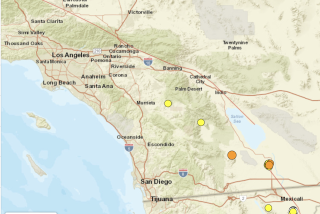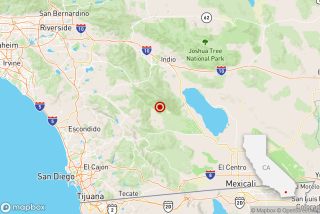5.1 Quake Hits Near Mojave; 1 Injured : Seismology: Scientists say it appears to be part of a series of jolts generated by Landers shaker. In the past two weeks, more than a dozen temblors have registered 5 or greater.
A magnitude 5.1 earthquake struck a desert area 11 miles northeast of Mojave on Saturday, and scientists from the U.S. Geological Survey and Caltech said it appeared to be part of a surge of seismic activity along the eastern front of the Sierra Nevada generated by the magnitude 7.4 Landers earthquake on June 28.
No damage and only one minor injury--a man who stumbled off a curb during the shaking, in Norwalk, 85 miles from the epicenter--were reported by authorities.
“It was like someone had picked up the fire station and dropped it,” said Capt. Jim Rummell at the Kern County fire facility in Mojave. Police in California City, the closest community to the epicenter, reported a wavelike motion, and windows rattled at nearby Edwards Air Force Base.
The notion of dropping was consistent with initial findings of earthquake scientists. They found that the quake was caused by an “oblique strike-slip” close to the Garlock and Sierra frontal faults, with the area on the south dropping, and the Sierra Nevada, on the north, rising.
Thomas Heaton, head of the Geological Survey’s Pasadena office, said there have been clusters of earthquakes at a number of Mojave and Owens Valley points since the Landers earthquake.
“The 7.4 is a very large earthquake,” he said. “It seems to have changed stresses over a very wide area.”
Egill Hauksson, a Caltech seismologist, said he prefers to call the quakes that have been occurring “sympathetic” to, rather than directly triggered by, the Landers temblor.
In the last several days, there have also been a number of earthquakes in the magnitude 3 range close to Barstow, between the Landers epicenter and the site of Saturday’s earthquake, as well as several quakes in the magnitude 4 range near Ridgecrest, northeast of Mojave.
The Geological Survey’s regional office in Menlo Park reported Thursday night that seismic activity relating to the quake surge had diminished in the Long Valley Caldera at Mammoth Lakes. But they said there has been a high rate of such activity at Lassen Peak and Mt. Shasta, in the Cascade range farther north.
Heaton said scientists believe it would be “foolish to say all these quakes at roughly the same time are complete coincidence.” He noted that in the average year, Southern California has about two quakes of magnitude 5.0 or greater. In the last two weeks, including aftershocks, there have been more than a dozen.
None of the latest activity is close to the notorious San Andreas Fault, the state’s longest and the one that scientists believe may one day be the site of the feared Big One, an earthquake as strong as magnitude 8.
Saturday’s earthquake, at 11:14 a.m., the strongest of the “sympathetic” earthquakes outside the Landers and Big Bear quake zones, was felt through much of the Los Angeles area, north to Ventura County and south to the edge of San Diego County. There were several minor aftershocks.
Times staff writer Stephen Braun contributed to this story.
More to Read
Start your day right
Sign up for Essential California for news, features and recommendations from the L.A. Times and beyond in your inbox six days a week.
You may occasionally receive promotional content from the Los Angeles Times.






